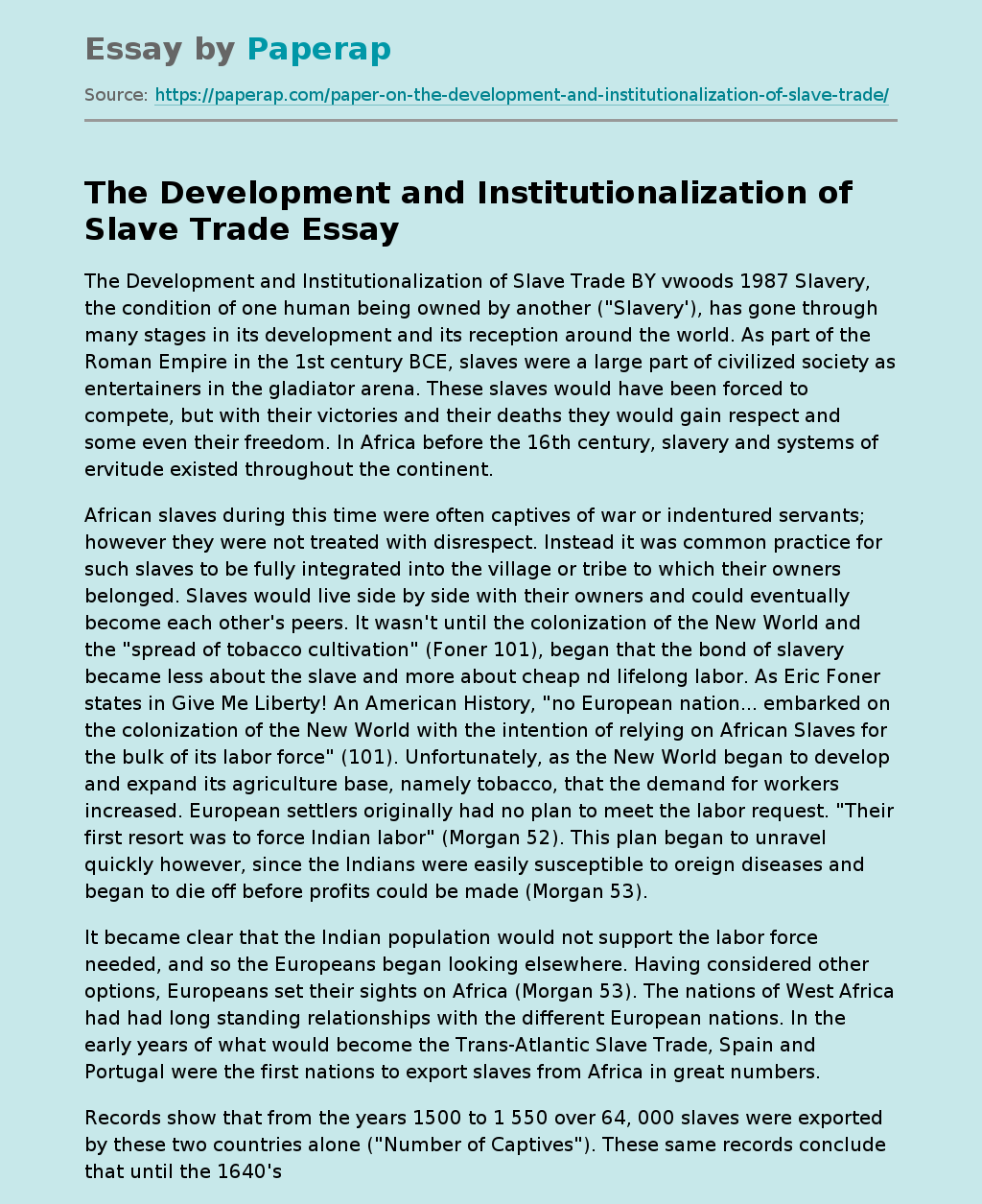The Development and Institutionalization of Slave Trade
The following sample essay on The Development and Institutionalization of Slave Trade deals with Europeans set their sights on Africa.
The Development and Institutionalization of Slave Trade BY vwoods 1987 Slavery, the condition of one human being owned by another (“Slavery’), has gone through many stages in its development and its reception around the world. As part of the Roman Empire in the 1st century BCE, slaves were a large part of civilized society as entertainers in the gladiator arena. These slaves would have been forced to compete, but with their victories and their deaths they would gain respect and some even their freedom.
In Africa before the 16th century, slavery and systems of ervitude existed throughout the continent.
African slaves during this time were often captives of war or indentured servants; however they were not treated with disrespect. Instead it was common practice for such slaves to be fully integrated into the village or tribe to which their owners belonged. Slaves would live side by side with their owners and could eventually become each other’s peers.
It wasn’t until the colonization of the New World and the “spread of tobacco cultivation” (Foner 101), began that the bond of slavery became less about the slave and more about cheap nd lifelong labor. As Eric Foner states in Give Me Liberty! An American History, “no European nation… embarked on the colonization of the New World with the intention of relying on African Slaves for the bulk of its labor force” (101). Unfortunately, as the New World began to develop and expand its agriculture base, namely tobacco, that the demand for workers increased.
European settlers originally had no plan to meet the labor request. “Their first resort was to force Indian labor” (Morgan 52). This plan began to unravel quickly however, since the Indians were easily susceptible to oreign diseases and began to die off before profits could be made (Morgan 53).
It became clear that the Indian population would not support the labor force needed, and so the Europeans began looking elsewhere. Having considered other options, Europeans set their sights on Africa (Morgan 53). The nations of West Africa had had long standing relationships with the different European nations. In the early years of what would become the Trans-Atlantic Slave Trade, Spain and Portugal were the first nations to export slaves from Africa in great numbers.
Records show that from the years 1500 to 1 550 over 64, 000 slaves were exported by these two countries alone (“Number of Captives”). These same records conclude that until the 1640’s, Spain and Portugal were the only two countries with significant numbers in the slave trade. In 1619, “the first Africans, twenty in all, arrived in Virginia (Foner 105), and with their arrival, the flood gates opened. It was at this time that other nations, namely Great Britain and the Netherlands, became more involved in the slave trade.
The British and the Dutch began importing laves to the New World to meet the needs of the colonies. The British colonies of Virginia and Maryland, as well as the Dutch colony in New York, made up the Chesapeake area, with each having its own large tobacco industries that needed to be fueled by slave labor. By the turn of the century, the British and the Dutch had imported nearly 640,000 slaves to the colonies. With the importation of large number 0T slaves came more ana more laws tnat trlea to ratlonallze slavery as well to create a never ending supply of new slaves.
Laws were passes regarding the birth of slave children as well as interracial children, with nearly all laws stating that if the mother was a slave that the child was a slave also, and became property of the slave owner. These laws consequently “made sexual abuse of slave women profitable for slave holders” (Foner 106). In such a short time Virginia had changed from a ‘society with slaves,’ in which slavery was one system of labor among others, to a ‘slave society,’ where slavery stood at the center of the economic process” (Foner 108).
Across the Atlantic, as stated efore, slavery was practiced throughout much of Africa among the various tribes and villages. However, with the increasing demand for slaves, coastal tribes would raid the inland tribes and capture their fellow Africans and sell them to the Europeans for small valuable trinkets. These newly captures slaves couldn’t possibly have known what their futures held for them in the New World, if they made it there. Within the borders of the New World slaves tried to escape whenever possible, but rarely succeeded in such a new and strange world.
Slaves newly imported were ubject to laws and customs that they didn’t understand, and since many of them came from different villages few could communicate with each other (Marques). Slave rebellion was kept under control by the fierce and open violence aimed at those who stepped out of line. Fear for one’s life suddenly became more important than freedom for many of the newly enslaved. As the years progressed the slave trade would see fluctuations in the number of slaves exported from Africa and imported to various countries as well as into the colonies, and then the United States of America.
Political tensions, including the Revolutionary War, contributed to decline in slave importation but it wasn’t until the 1831’s that the slave trade essentially ended, at least for the United States. As History is bound to repeat itself, in recent times, there are numerous occasions were slavery has peaked and then declined. Fortunately these recent incidences, have never reached such catastrophic and saddening numbers as the Tran-Atlantic Slave Trade had.
The Development and Institutionalization of Slave Trade. (2018, Jun 14). Retrieved from https://paperap.com/paper-on-the-development-and-institutionalization-of-slave-trade/

